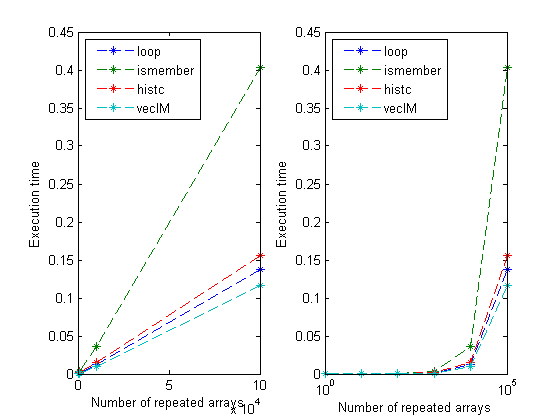Inverse Mapping (update)
In a follow up comment to the inverse mapping post, Lucio noted that loopFR could be fully vectorized and he is right. Rather than update that post directly, I thought I republish the loop-free code here and compare times again.
Contents
Tidy up to start.
clear format short g
Recap the Problem
Sample Input and Results
Supppose array a contains values that we expect to see in another array, Minit.
a = [1 3 5 7 8] Minit = [1 3 5; ... 3 5 7; ... 3 7 8]
a =
1 3 5 7 8
Minit =
1 3 5
3 5 7
3 7 8
Let's build a replacement matrix for Minit in which its values are replaced with their indices in the list a.
Mwanted = [1 2 3; ... 2 3 4; ... 2 4 5]
Mwanted =
1 2 3
2 3 4
2 4 5
Algorithms
We previously compared these algorithms:
- loop (via loopFR)
- ismember
- histc
Here's loopFR, for reference:
dbtype loopFR1 function M1 = loopFR(M,A) 2 % loopFR replaces M with its indices from A. 3 4 % First set up the inverse mapping array. Initialize it to zero, and the 5 % size is the maximum number the array. Note that I get away with this 6 % here because all of my numbers in both A and M are positive integers. 7 imap = zeros(1,max(A)); % inverse mapping array 8 % Now fill the inverse map, but placing in the location specified in each 9 % element of A, the index of that element in A. 10 % If A = [1 5 4], then imap = [1 0 0 3 2]. 11 imap(A) = 1:length(A); 12 M1 = M; 13 for k = 1:numel(M) 14 M1(k) = imap(M(k)); 15 end
and let's now add the fully vectorized version, vecIM to our comparison.
type vecIMfunction M1 = vecIM(M,a) %vecIM Inverse mapping. imap(a) = 1:length(a); M1 = imap(M);
Time the New Algorithm and Retime the Former Ones
N = [1 10 100 1000 10000 100000]; % repetitions to test t = zeros(length(N),4); % set up the timing collection array for n = 1:length(N) % Make a larger matrix to search. % loopFR M = repmat(Minit,N(n),1); tic; M1 = loopFR(M,a); t(n,1) = toc; % ismember tic; [M2,M2] = ismember(M,a); t(n,2) = toc; % histc tic; [M3,M3] = histc(M,a); t(n,3) = toc; % vecIM tic; M4 = vecIM(M,a); t(n,4) = toc; if ~isequal(M1,M2,M3,M4) disp('oops') end end
Timing Results
disp(' Counter loop ismember histc vecIM') disp([N' t]); subplot(1,2,1) plot(N', t, '--*') xlabel('Number of repeated arrays') ylabel('Execution time') legend({'loop','ismember','histc' 'vecIM'},'Location', 'NorthWest') subplot(1,2,2) semilogx(N', t, '--*') xlabel('Number of repeated arrays') ylabel('Execution time') legend({'loop','ismember','histc' 'vecIM'},'Location', 'NorthWest')
Counter loop ismember histc vecIM
1 9.0514e-005 0.00028691 2.2349e-005 5.5594e-005
10 7.2635e-005 0.00024612 3.1568e-005 5.9225e-005
100 0.00018522 0.00054839 0.00018131 0.00014471
1000 0.001263 0.0034977 0.0013865 0.00097079
10000 0.012539 0.035746 0.014809 0.010385
1e+005 0.13758 0.40348 0.15652 0.11654

Comments
I made a mistake in the original post by not recognizing that loopFR was completely vectorizable. It's often true that if you have the same indexing expression on the right- and left-hand sides, such as on line 14 in loopFR, you can get rid of the loop completely. As you can see, the fully vectorized solution vecIM has the least overhead of all the solutions posted so far. Any more comments, algorithms, or new results? Please add them below.
Published with MATLAB® 7.2
- 범주:
- Vectorization









댓글
댓글을 남기려면 링크 를 클릭하여 MathWorks 계정에 로그인하거나 계정을 새로 만드십시오.